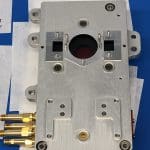Hillsboro, Oregon, May 2020 – Beginning with technology development efforts in the mid-2000s, flights of the Airborne Multiangle SpectroPolarimetric Imager (AirMSPI) starting in 2010, and extending to the current Multi-Angle Imager for Aerosols (MAIA) project, Hinds Instruments has worked closely with NASA’s Jet Propulsion Laboratory (JPL) to develop an aerospace qualified Photoelastic Modulator (PEM). Initially funded by NASA’s Earth Science Technology Office and later by NASA’s Earth System Science Pathfinder Program Office, the goal of this work has been to make polarimetric measurements of airborne particles in the Earth’s atmosphere. MAIA will allow scientists to accurately measure the distribution and properties of these particles, known as aerosols, helping to link these airborne pollutants to human health impacts. Research into this application was led by David Diner and others at JPL as noted in 2007 and 2010 publications (Diner, et al, Appl. Opt. 46, 8428 (2007); Diner, et al, Appl. Opt. 49, 2929-2946 (2010). The speed, precision, durability, and ease of use of the PEM made it the preferred device for polarization modulation in this application. Atmospheric imaging is accomplished through a dual-PEM camera module, developed under multiple subcontracts with several revisions to the PEM design. After achieving successful AirMSPI flights at 65,000 feet aboard NASA’s high-altitude ER-2 aircraft and extending the spectral range based on hardware designed and tested for the second generation airborne instrument (AirMSPI-2), the team is currently building the satellite-based MAIA instrument. Successful imaging from Low-Earth Orbit will allow monitoring aerosol properties over a globally distributed set of target areas.

JPL’s first statement of work focused on a detailed design proposal to ‘ruggedize’ the PEM for integration into the AirMSPI camera. This project included a design review with JPL engineers to establish the requirements for high altitude flight. Once the design specifications were determined, Hinds agreed to deliver the first test units. In turn, JPL established a series of in-lab tests for the new design. This included

detailed engineering analyses and environmental testing with the goal of successful data collection aboard the ER-2. Development of AirMSPI involved tests on a number of PEMs early in 2006, leading to the first ruggedized dual PEM (pictured, above). An updated design is shown at left. A detailed description of this work can be found in a press release from 2007.
Subsequent developments resulted in a revised design incorporating an optical probe to measure and control the PEMs. An in-depth description of the AirMSPI imaging polarimeter can be found in Diner et al., Atmos. Meas. Tech. 6, 2007-2025 (2013). AirMSPI has subsequently flown on the ER-2 in numerous scientific field campaigns.
Development success gained from the AirMSPI project was rolled into the new MAIA project, selected by NASA under its Earth Venture Instrument program in 2016. A press release from NASA outlines the objectives of the MAIA project, which focuses on measuring the impacts of different types of airborne particulate on human health. Progress on the PEM design from the AirMSPI and AirMSPI-2 technology developments served as valuable benchmarks for JPL’s research and development team, and provided an effective foundation for the MAIA project. Building upon the AirMSPI and AirMSPI-2 designs, Hinds continued to work closely with JPL to qualify a similar PEM for the MAIA project. To qualify the device for

flight in space, the design team needed to reduce the mass of the PEM and conform to tight interfacing specifications using only space-qualified parts. These goals were met without losing any essential performance characteristics of the PEM. On the MAIA project, Hinds engineers addressed incremental design adjustments for the optical head, including another round of environmental and vibrational tests, while JPL assumed responsibility for the PEM drive electronics. Both development teams coordinated efforts to ensure the final PEM design would withstand launch and maintain full functionality in orbit. The final MAIA PEM design was produced and delivered to JPL in March, 2019 (pictured). The MAIA satellite instrument is currently scheduled for launch in 2022.
Over the course of nearly two decades working with veteran scientists and engineers from JPL, Hinds Instruments has demonstrated the ability to successfully incorporate its proprietary PEM technology into aerospace applications. The integration of the PEM into the MAIA instrument will provide researchers with a new and improved platform for the analysis of aerosol pollutants over major cities around the globe.
Hinds Instruments is the world leader in developing and supplying systems for polarization analysis in a broad range of applications. With 40+ years of experience in polarization modulation and analysis, Hinds Instruments PEMs are proven tools for laboratory and research applications on land, and perhaps now even in space. PEMs operate on principles of resonance (20-84 kHz), require low power and have no moving parts. Hinds’ family of products includes modulators, optical choppers, Stokes polarimeters and birefringence measurement systems. For more information, please contact Hinds Instruments.
